There are 3 days left before Bitcoin halving, and the Runes protocol will be launched on the same halving block!
I’m sure you’ve heard of Runes Protocol, but I wanted to share my thesis, why I’m short-term bearish but long-term bullish, how to prepare, and which protocols/tools to use so as not to miss out.
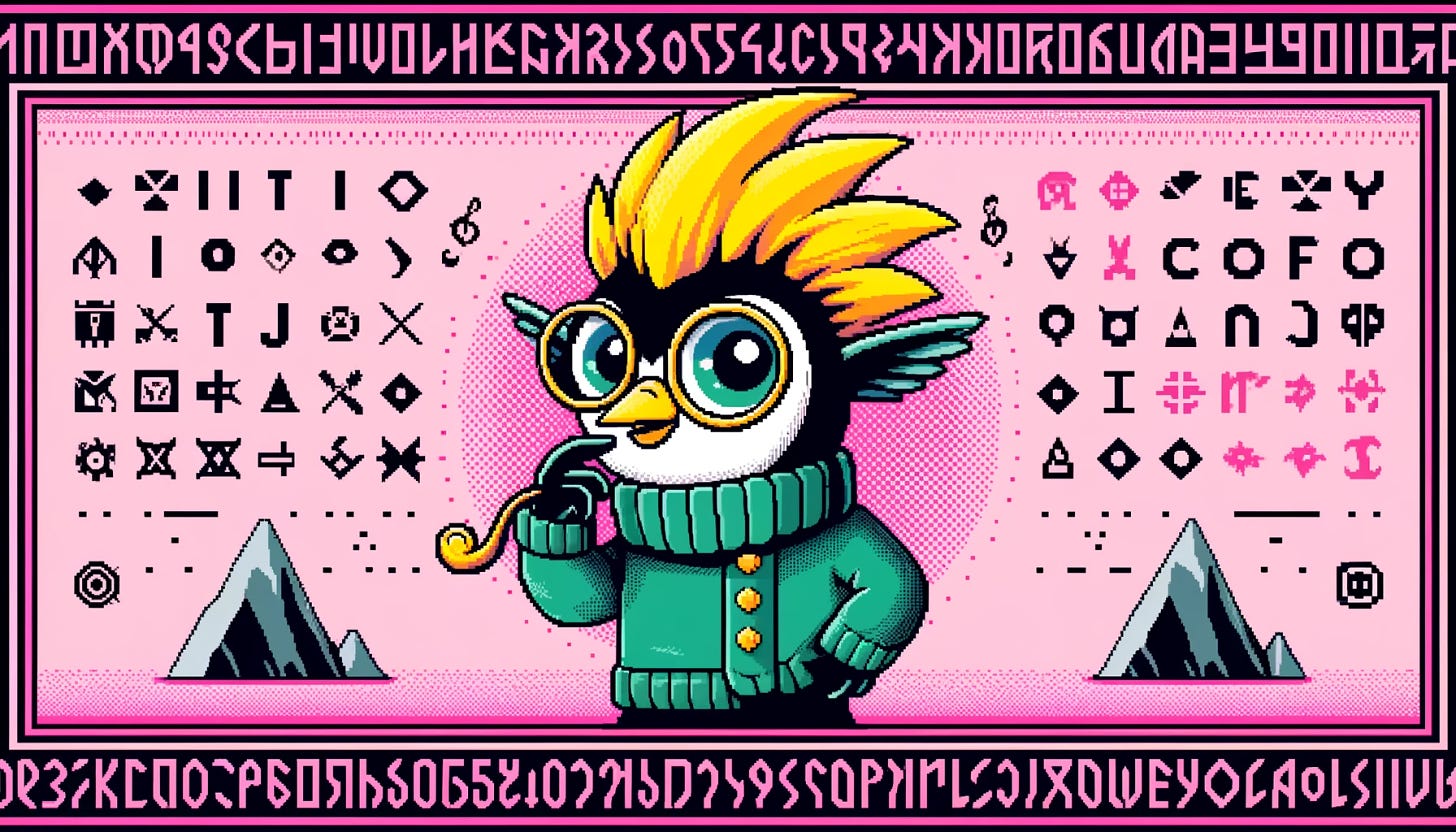 Humpty Dumpty • Penguin • Rune
Humpty Dumpty • Penguin • Rune
But first, check out this week’s Airdrop Farm!
This Week on the Farm
- BOB : Bitcoin L2 brings the security of BTC through Ethereum EVM. Surprisingly, there is a long list of strong partners such as OKx and Mechanism Capital. Bob will launch halving rune trading by depositing Ethereum assets and Farm BOB Spice (points) as the Bob L2 mainnet goes live. Tip: Deposit wBTC or tBTC to get a 1.5x points multiplier. The event starts on March 27th, and there are 7 days left before the deposit deadline.
- → You need an invite code: use my "50sj3z" or click here.
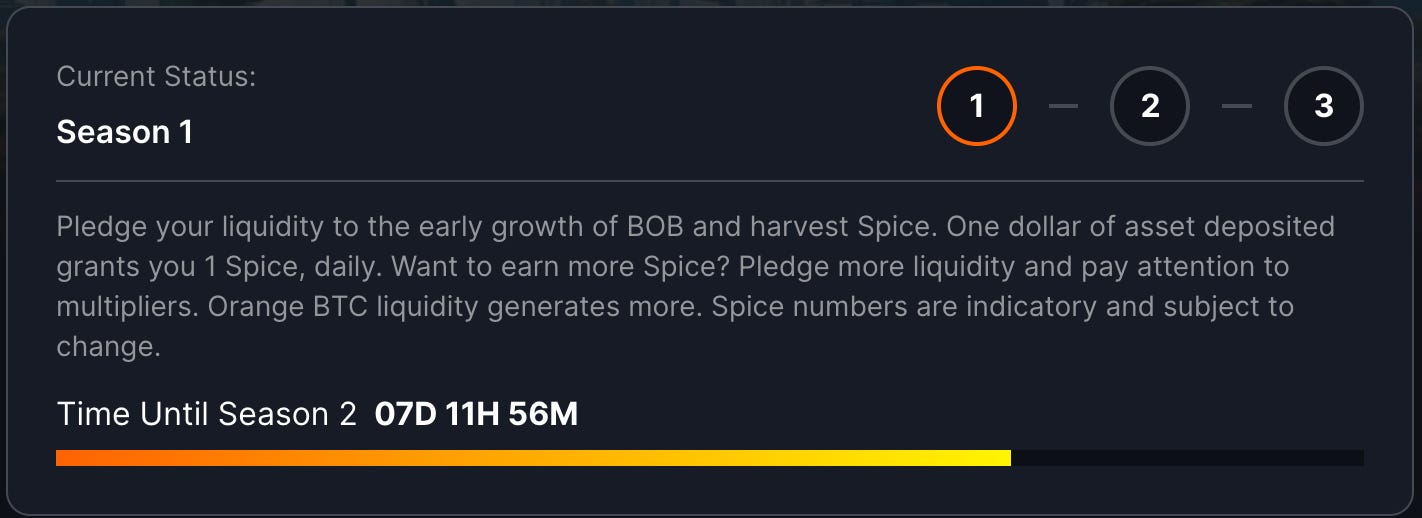
- Liquidium : Lend and borrow Ordinals/BTC. Could become a blue chip BTCFi protocol like Aave. Got VC funding and is currently running an airdrop points system.
- → Try it here.
- Karak : A competitor to EigenLayer that just raised a Series A at a $1B valuation. You can re-use EigenLayer LRT to get Eigenlayer, LRT, Karak XP points all at once. I don't believe they can beat Eigenlayer, but you won't lose much by farming it either.
- → Use my permanent code IGNAS to start here.
- Elixir - Order book liquidity network raises $8M at $800M valuation from Crypto Hayes, Sui, Amber, and others. Elixir allows providing liquidity and earning rewards to order book exchanges, including Vertex, Bluefin, and others.
- The points (potion) system is online, you can earn mysterious treasure chests by depositing ETH and minting elxETH. Your ETH will be locked until the mainnet launch in August.
- → Join my invitation here.
Why I’m Bearish on Rune Protocol (Short-Term)
I will start by sharing my bearish stance on Rune.
I expect the pre-Rune market to remain hot until the protocol is released. Assets such as Runestone, RSIC, PUPS, etc. have already been pumped heavily, and holders of these assets will receive Rune token airdrops. New Rune tokens may see strong initial performance for some time.
But the market will cool down, just like NFTs plummeted after the JPEG release. Here are a few reasons:
- Bitcoin transaction fees will become prohibitively expensive for traders with smaller capital actively trading Runes (which in turn will drive the development of Bitcoin L2).
- Since UTXOs and BRC20s are traded like NFTs, runes *probably* won’t significantly improve the BRC20 trading experience.

- The early UniSat and Ordinal wallet transaction interfaces were the same as BRC20, with 1) the number of tokens and 2) the price of each package traded in one transaction.
- The amount of newly issued Rune tokens will be staggering: dozens or hundreds of new tokens will be minted every day (at high gas costs), diluting traders 1) attention 2) capital inflows per token.
- Utility Runes are meme coins similar to BRC20. At least at first, the excitement of the “new” will wear off. Especially if no Rune token can sustain the upside, Degens will lose money.
- In addition, Casey Rodamor's own Rune 0 (UNCOMMON•GOODS) will be difficult to circulate because it 1) can be minted freely for 4 years, and 2) is limited to 1 coin per transaction.
Why I am bullish on Rune Protocol (long term)
If I'm right, and the Rune hype cools down soon after Rune Protocol launches, the best opportunities will come after the dump.
Here are the reasons:
Speculations about the narrative flooded in.
The first wave is triggered by excitement about something new and shiny. It usually comes from innovative technology or simple meme potential. Meme tokens are a bit like gambling: the absolute majority of meme coins rarely appear in the second wave.
However, narrative speculation based on technological innovation has a greater chance of resurfacing after the first wave of hype subsides.
Ordinal Inscriptions are introduced in December 2022. But the first major wave comes with the launch of BRC20 in May 2023. The amount of BRC20 that can be freely minted decreases rapidly, but the second and third waves arrive in late 2023 as developers continue to build.
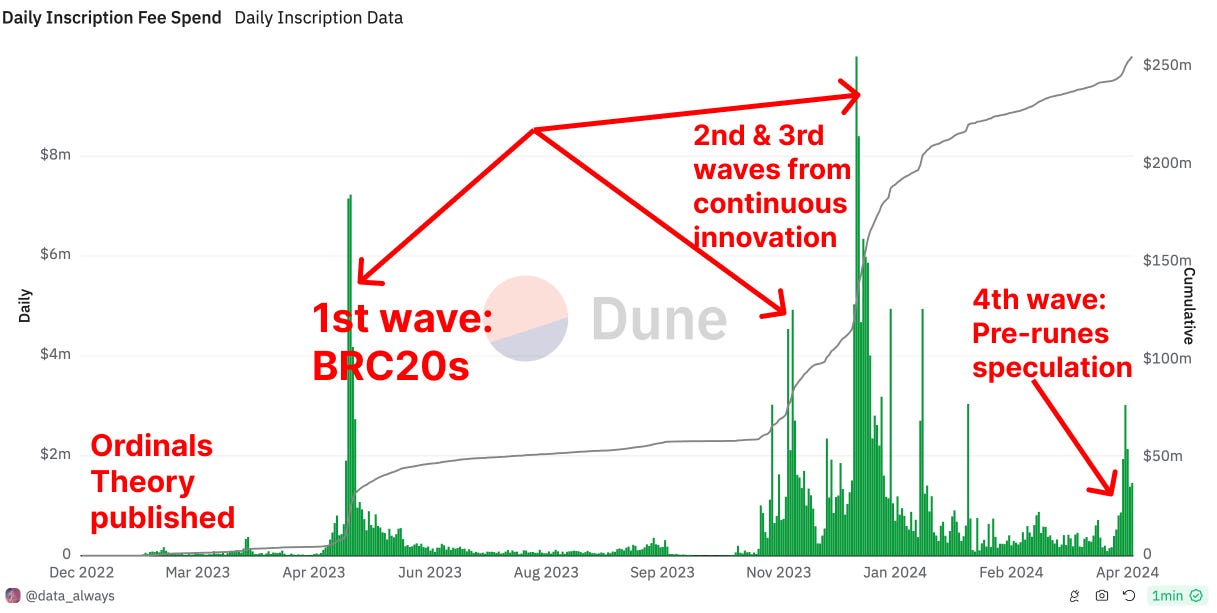
We are now in the fourth wave of speculation before the ordinals and runes.
While many narratives will not survive the first wave ( check ERC404 txs ), I believe Runes will have a fifth wave, a sixth wave, and more.
Because:
- Multiple protocols are building infrastructure for Rune tokens. But it takes time to develop new DEX/marketplaces. For example, Saturn is building a familiar-looking DEX for Runes, but it will take time to make the user experience smooth. I will share more protocols to follow below.
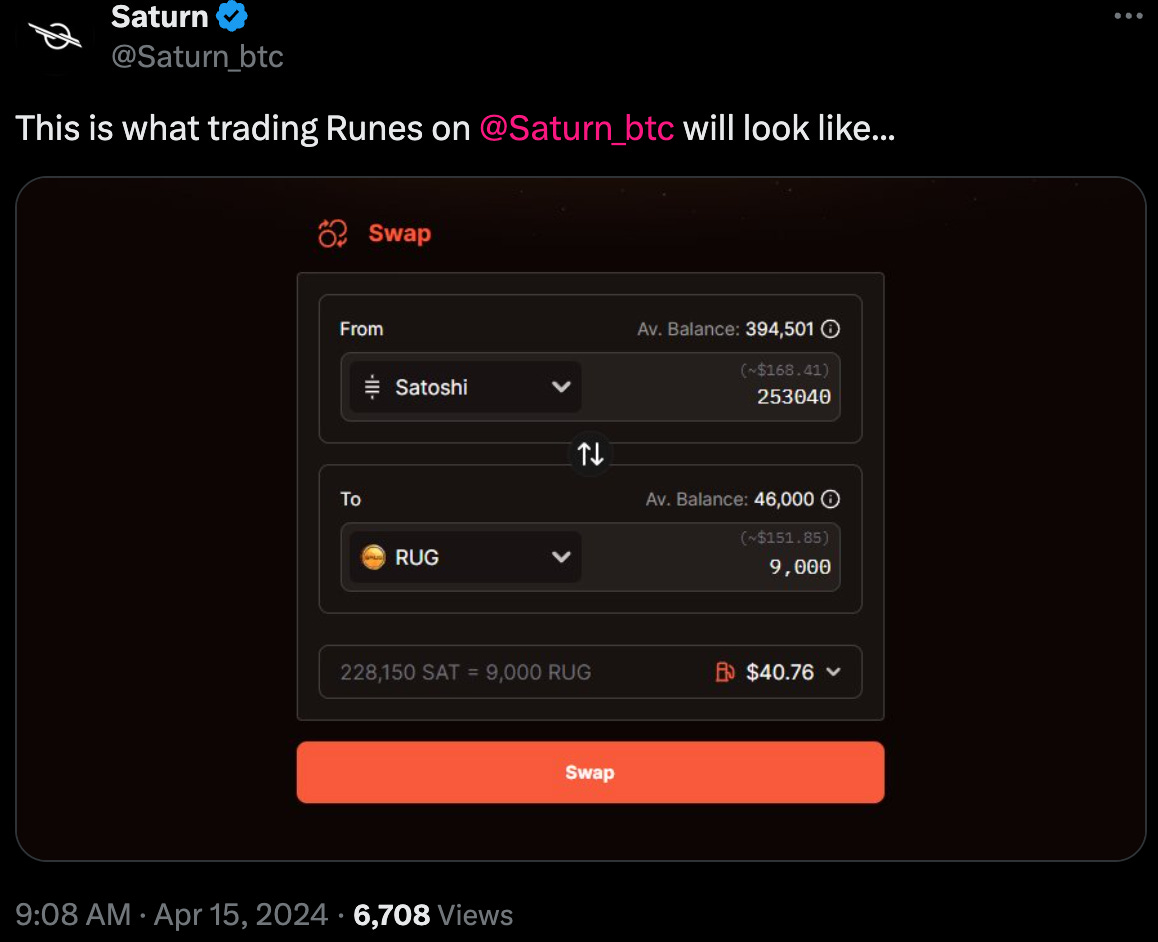
- Runes Protocol aims to consolidate the BTCFi industry around a single development standard. Imagine Ethereum without the unified ERC20 standard - tokens are not interchangeable between Aave and Uniswap. This is the current state of Bitcoin. Before Runes, we already had BRC20, CBRC-20, ARC-20, BRC-420, etc. It's a mess.
In the long term, I am also bullish on Rune because it identifies all three pillars of a thriving crypto ecosystem. Here is my framework for this bull run.
In my opinion, the success of any crypto ecosystem is driven by three key elements: technological innovation, token minting opportunities, and compelling storytelling. Here’s how Runes fit into the mix.
- Technological innovation: We were told that NFTs and tokens were impossible on Bitcoin. Yet Bitcoin NFTs have outperformed Ethereum NFTs in this cycle. ORDI, the first BRC-20 on Bitcoin, trades for $1 billion on Binance.
- The magic is in transforming fungible satoshis into non-fungible satoshis. When a satoshi has an inscription on it, it is no longer equal to another satoshi.
- This is one of the most exciting “zero to one” innovations of this cycle.
- Token Printing: This is one of the reasons we have crypto cycles. During every bull run, new tokens are created out of thin air and given crazy valuations. Just as central banks can print fiat currencies, we tend to issue too many tokens to accommodate the flow of money and attention into the crypto space. So, the market crashes.
- This cycle is no exception. I wrote more about how it happened even before the bull market began.
- However, token printing was reserved for smart contract blockchains like Ethereum/Solana. Until the Ordinals theory inadvertently gave birth to BRC20.
- I worry about BTCFi because of unlimited token printing. BRC20 (and runes) can be minted easily without any real value accumulation because there are no smart contracts on BTC. But the Ordinal community is doing this by assigning OG value to early Ordinal NFTs and airdropping tokens of these NFT collections.
- The Schelling point convergence point was successfully found. Furthermore, without any direct value accumulation, all BRC20 tokens are essentially memecoins. Only ORDI has gained attention as the first BRC20 token, but now PUPS may have crossed the Rubicon and become the real memecoin on Bitcoin. The higher the price of PUPS, the higher the conviction it arouses among the degenerates. Finally, the BTCFi ecosystem continues to grow, and its native token challenges memecoin and rationalizes BRC20/Runes as value accumulation tokens. More on this later.
- Compelling Storytelling: Storytelling gives life to the technical aspects and the token economic model, turning them into something people can connect to, believe in, and become a part of.
- For example, Bitcoin ordinals as immutable NFTs on the most secure and decentralized blockchain is a sexy story. Also, memecoins on Bitcoin for baby boomers? Come on, that’s way cooler than memecoins on Solana or Ethereum.
- Crypto Twitter is catching up to the technical innovation of Ordinals/Runes, and the narrative is hot.
This short-term bearish but long-term bullish scenario is probably the best case scenario if you are late to the pre-launch Rune tokens. It gives you plenty of time to learn and prepare before the second wave of Rune tokens hits once the hype dies down.
The best time to learn was yesterday, and the second best time is today. So, here is a brief introduction to runes.
What You Need to Know About Rune Protocol
Runes Protocol was developed by Casey Rodamor, the creator of Ordinal Theory, as a rebuke to BRC20. Casey is not a fan of BRC20, so it is expected that what Casey did with NFTs, he will do again with fungible tokens.
You see, BRC-20 tokens use JSON data (a text-based data format) inscribed in Satoshi. They are more like NFTs than fungible tokens. For example, before selling or transferring these tokens, you need to "register" (via an on-chain transaction on BTC).
Additionally, BRC-20 can generate “junk” or “surplus” transactions that clog the network.
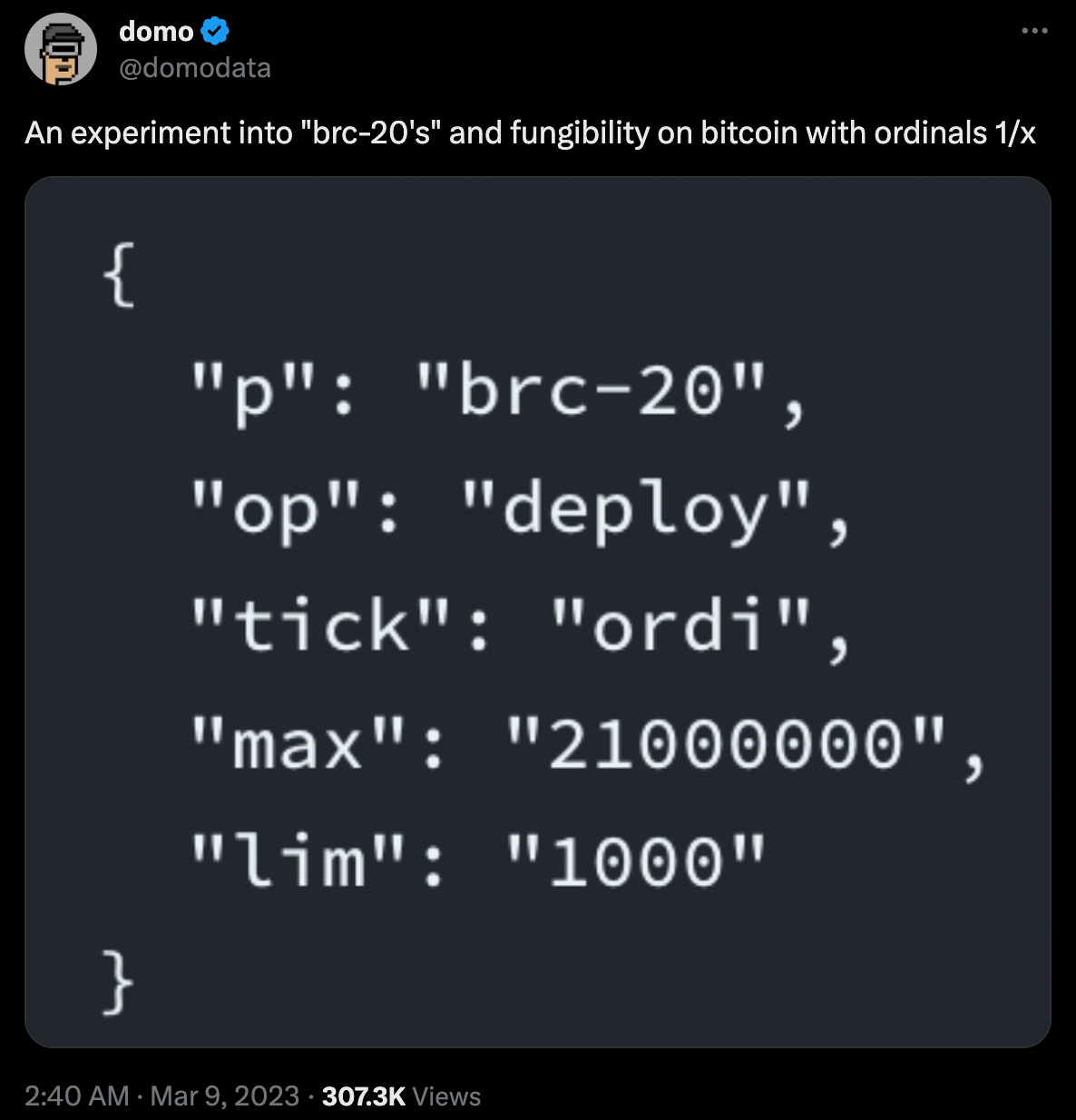
Rune, the hand uses the UTXO model, which makes everyone scratch their heads. Here is my breakdown:
Ethereum follows an account-based model, whereas Bitcoin uses UTXO (unspent transaction output) to track user status and balances.
For example, if you have a UTXO worth 1 BTC and want to send someone 0.3 BTC, the transaction will use the entire 1 BTC UTXO as an input. The transaction will then create two outputs: one sending 0.3 BTC to the recipient, and another returning 0.7 BTC (minus any transaction fees) to your address as two new UTXOs.
So technically, when you say, “I own 1 bitcoin,” you should really be saying, “I own some UTXO that allows me to spend 1 bitcoin.” (Credit to Alchemy for this quote. )
In the example above, when you use a 1 BTC UTXO as input, that UTXO will be “destroyed” and two new UTXOs will be minted: 0.3 UTXO to the recipient, and 0.7 UTXO (minus fees) to you.
As you can see, these UTXOs are like NFTs!
However, while each inscription (like BRC20) is unique, every unit of Rune is the same. They are interchangeable tokens. You can transfer Rune like regular Bitcoin, instead of inscribing BRC20 every time you send it.
For Runes, UTXO can now store 1 Bitcoin, 100 Rune Token A, and 50 Rune Token B as Runes.
Tip : Create multiple UTXOs by sending the amount of BTC you are willing to invest per rune to a new wallet. This way you can get multiple tokens without waiting for the previous transaction to complete. Or use Luminex.
A Rune (not to be confused with a Rune Sequence Number ) is a Rune Protocol message that is stored in a Bitcoin transaction output when you send a UTXO.
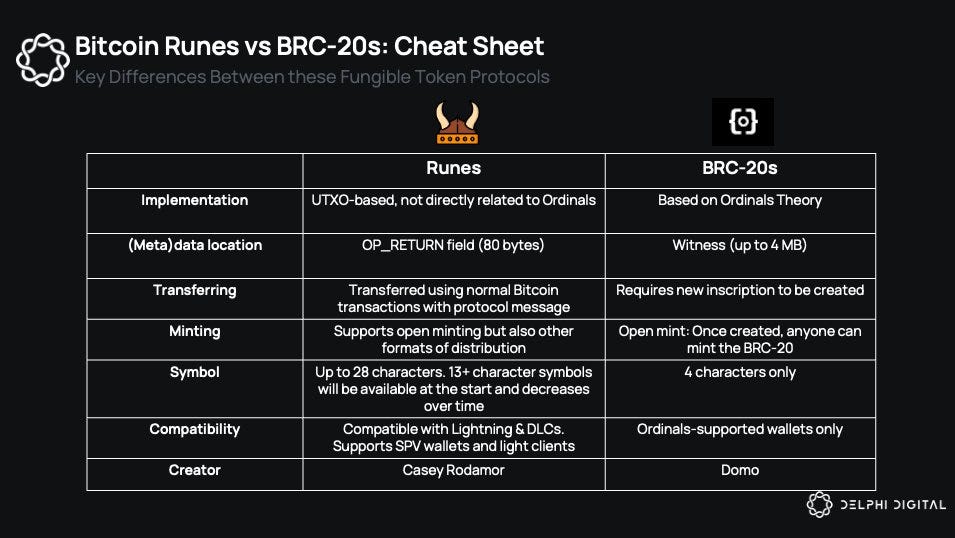
I share this because once Runes is released, you’ll quickly start seeing discussions on Twitter using terms like “Runestones,” “Etches,” and “Edicts.” People will try to trade runes but run into problems, leading them to seek answers on Twitter.
Runes - Rune Protocol messages - can include etching (deploying) new runes, casting existing runes, and transferring runes from one address to another.
Etching is the way the Etcher casts a rune for the first time. Once etched, the properties cannot be changed.
You can learn all the cool words to impress your degen friends in Casey 's official documentation.
My favorite is the monument of burning runes.
Finally, there are some other simple terms and facts about runes that you should know:
- Rune Names : Initially only names with 13 characters or more will be available; this limit is reduced by one character every 4 months until all names are accessible after 4 years.
- Rune Number : Indicates the order in which the runes are created, starting with "Rune 0", then "Rune 1", etc.
- The first rune UNCOMMONGODS - a free mint with no supply cap, only 1 UG per mint. 1 UG is basically the price of a Bitcoin transaction fee.
- Rune ID : generated based on transaction block and location, for example "500:20"
- You can cast runes by entering the rune ID. For example, the RuniGun bot on telegram will allow casting runes by rune ID. So if you know the ID, you are not dependent on a 3rd party UI for casting. The bot can be checked here (disclaimer, I am not affiliated, just discovered this myself on X).
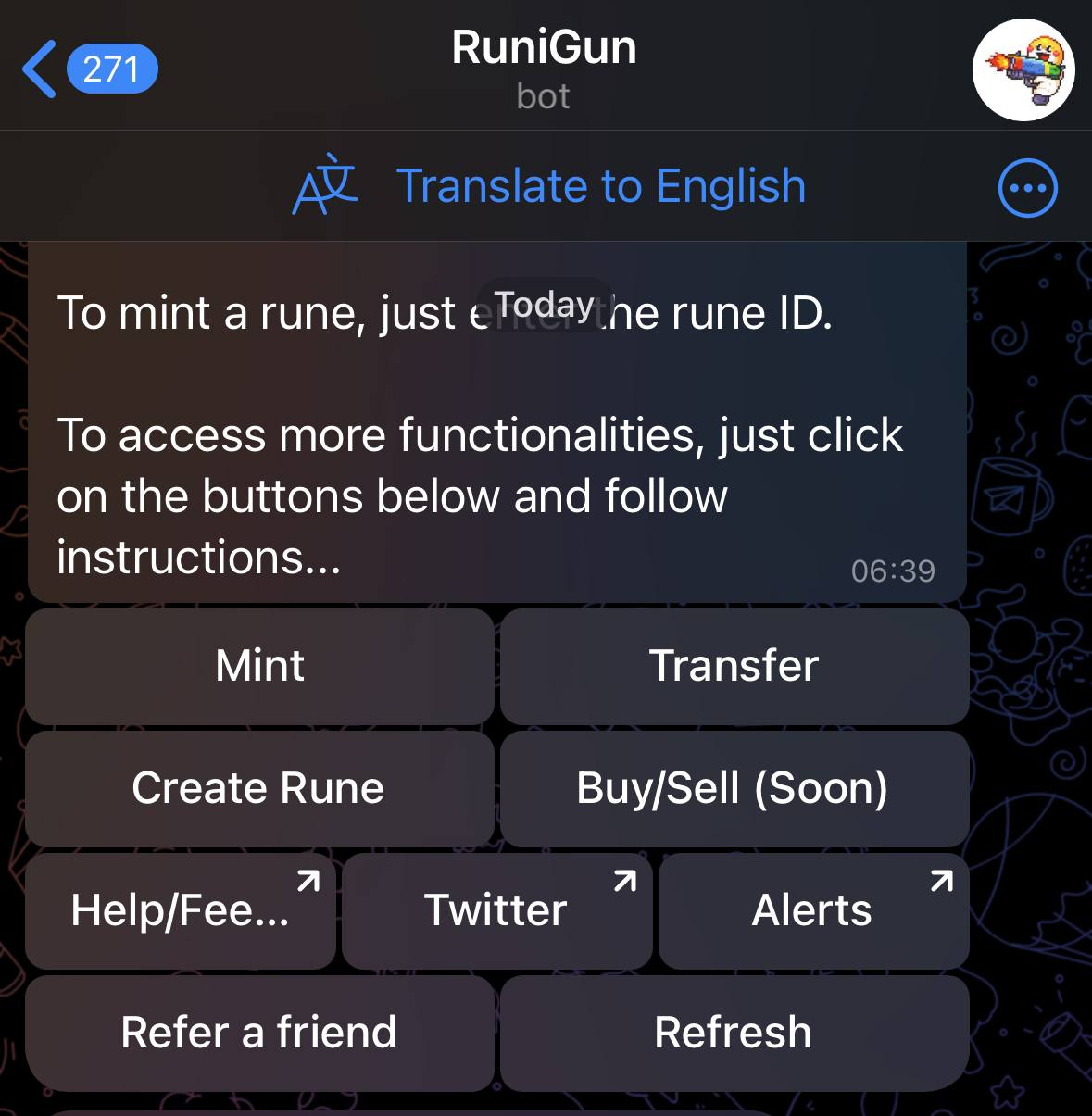
- Rune Symbol: Rune, or the non-unique currency symbol $, or the universal currency symbol ¤. ⧉🧿
More technical terms from Leonidas can be found here.
A simple comparison of BRC20 and Runes by Delphi Digital.
Projects, protocols, and tools to watch
I originally planned to write a post on "How to position yourself for the Rune Protocol launch". However, there are already multiple similar-looking threads on X with the same protocol.
The key thing to understand is that the Rune game is ongoing and has launched multiple pre-run protocols, promising to airdrop Rune tokens after launching the protocol on the Bitcoin halving block.
The hype started with the RSIC protocol, which mysteriously airdropped RSIC NFT miners to the Ordinal OG wallet.

At the time I said “something huge is brewing in the BTCFi space” but I didn’t actually know how it would pan out. We now know that RSIC launched a competition to win attention for Rune degens.
If you don’t hold RSIC, I don’t think now is the best time to enter: By holding RSIC you mine RSIC points, which will reward you with RSIC Rune tokens. In theory, RSIC should be trading at $0 on the halving block.
In response to the RSIC team (keeping 10% of RSIC for themselves and not being transparent about the airdrop criteria), Leonidas launched a Runestone airdrop to 112.4k OG wallets. By holding Runestones, you will receive not 1, but 3 RuneMemeCoins
“Later this month, later this year, when we become the top memcoin in the world” - Leonidas
Runestone is currently trading at a market cap of $549 million, making it the second largest (after Rune Cubs + PUPS) pre-Rune series.
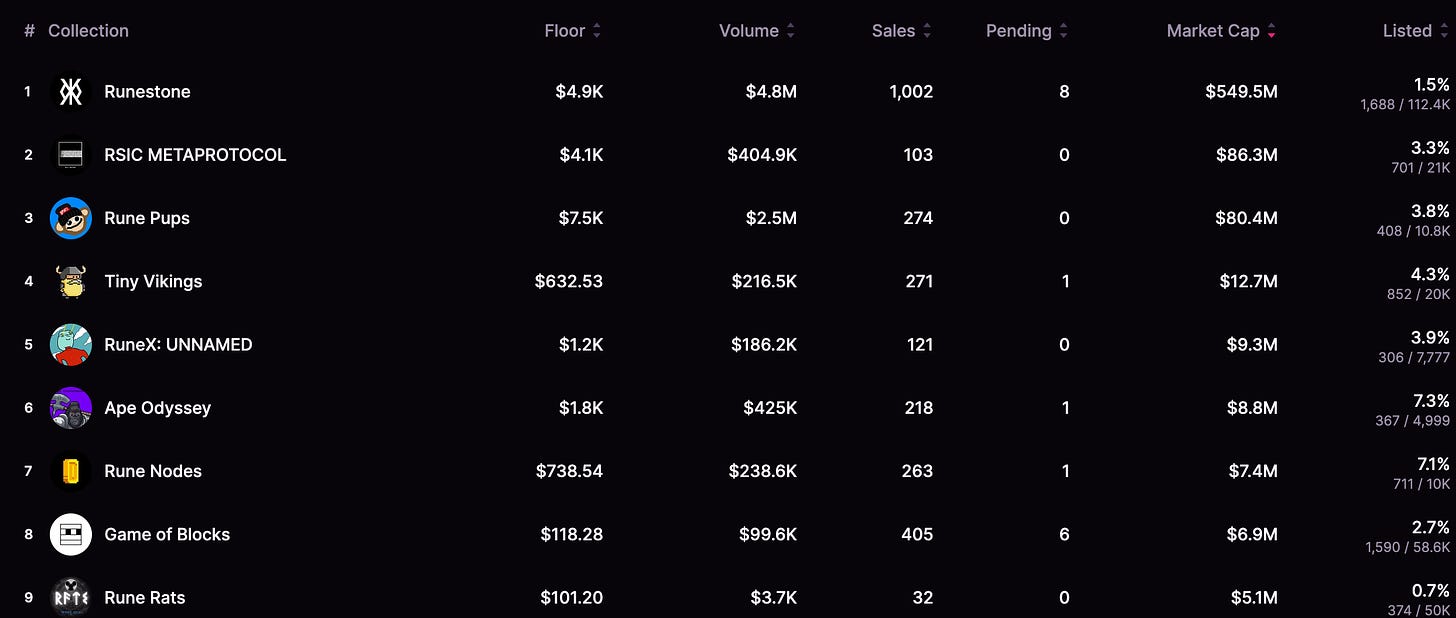
But as the value of RSCI continues to drop as it approaches the halving, the actual RSIC valuation is $588 million (based on the price of $0.028 per 1 RSIC rune on the whale market).
Rune Pups ($80m) + PUPS memecoin ($421m) for a combined transaction valuation of $501m. Keep in mind that if allocated to Rune Pups, both Rune Pups and PUPS token holders will migrate to Runes, with 23% allocated to Rune Pups and 77% to PUPS.
There are generally good arbitrage opportunities with Runes Pups NFTs, PUPS on Unisat, and Bridge Pups on Solana.
Not financial advice, but would you be willing to emulate these valuations? If my short-term expectations are correct, their valuations should drop shortly after launch.
Regardless, this is a speculative decision you should make on your own. There are multiple other Rune Protocols with valuations under $100 million. Check out Magic Eden's full list.
I’m not selling though. I entered the ecosystem early and am willing to hold. In addition, these three assets are becoming the Schelling Points of the Rune ecosystem, and I hope they can maintain their value and receive more airdrops.
In the long run, new protocols seem poised to capitalize on the Rune Protocol hype. Here are some protocols and tools you can start using.
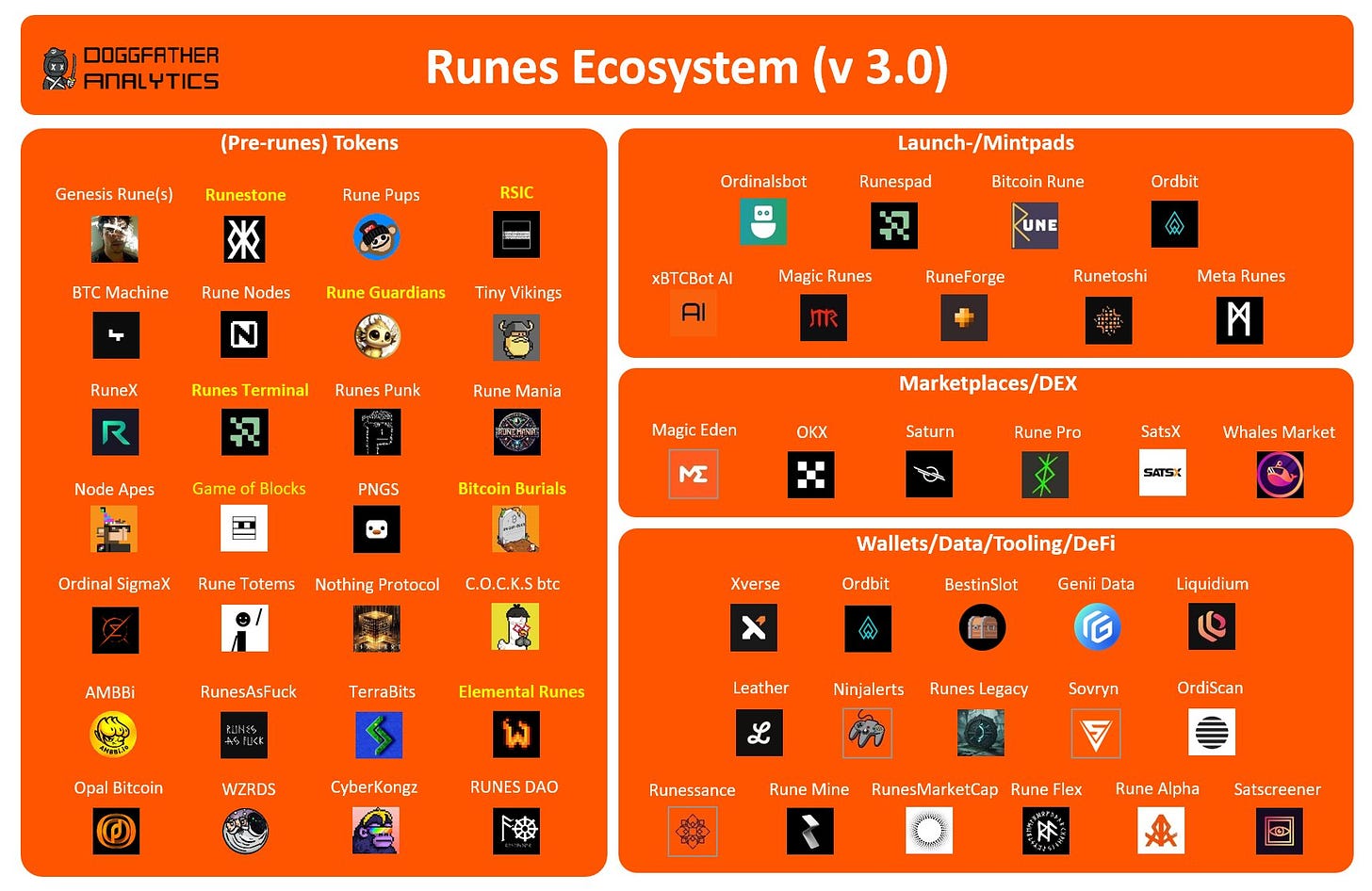 Follow doggfather for the latest on Rune Protocol
Follow doggfather for the latest on Rune Protocol
Famous Protocols
- Luminex : Mints runes, can split UTXO, mint multiple runes with the same wallet. Popularized by Xverse wallet, so it might be good.
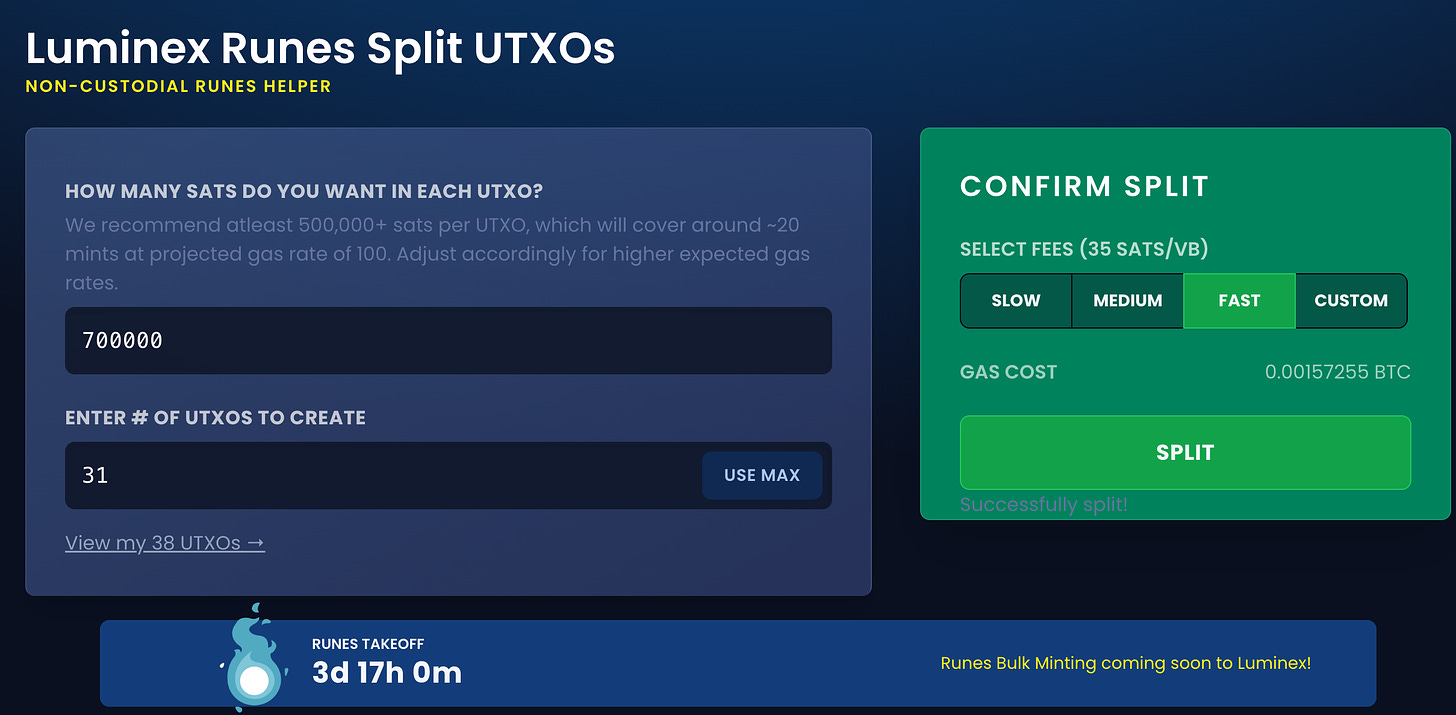
- Sovryn : Exchange/lending runes with their own sidechain. Launched at halving. Sovryn will launch their DEX on Bob L2 which is the same link I recommended.
- RunePro : Building dex and Etching protocols. No livestream yet. https://twitter.com/Rune_Pro
- Rune Bitcoin : Provides etching and transfer services for runes, while also building a marketplace and a DEX.
- Runessance : A lending protocol for Runes and Bitcoin.
- Liquidium : Borrow ordinals and runes. Or earn bitcoin gains. Points system live. Liquidium airdrops have points.
- Saturn : AMM/Orderbook exchange for Bitcoin assets. Liquidity may not exist during Runes release.
- RuniGun : Telegram bot for casting, creating and managing runes. Couldn't export my private keys, so be careful.
But you might trade Runes with Magic Eden and Unisat and OKx Web3 wallet (if you are a mobile user). Personally, I use Unisat, Xverse and OKx wallet interchangeably.
I’ll be doing a dedicated blog post about dApps in the BTCFi ecosystem in the future. There’s a lot to unpack here, so be sure to subscribe.
Useful Rune Tools
- SatScreener : A real-time token aggregator for the Rune and Bitcoin ecosystem. Since Coingecko/CMC sucks for the Bitcoin ecosystem, Satscreener is the place to go to track token information.
- Runesmarketcap : Find Rune Protocol by origin, market cap, type, and more.
- Runealpha : Rune browser, live data, and etching (casting) protocol all in one. Very useful.
- Rune Terminal : Build scanners, coin minters, and launchpads. Has its own serial number and will be rewarded with RUNI airdrops after the halving.
It’s still early, so let me know in the comments about the best tools and protocols for runes!
One last thing before I sign off: it’s still early days for BTCFi. It’s like traveling back in time to Ethereum DeFi before Uniswap was born in 2019-20. The opportunities are going to be plentiful, so be sure to keep learning and clicking buttons!







